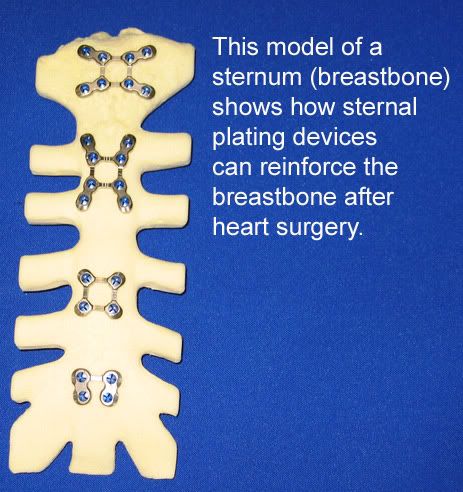Hi, Jim, there are several new methods of closing the sternum after OHS. Below is a diagram of the devices used to close my chest. A link to the company's website is below that. My surgeon said he prefers Talons to Plates because Talons do not require drilling holes in the sternum. As well as holding the sternum securely closed, they were designed to reduce the potential for infection by clasping rather than piercing the bone as is necessary with both wires and plates.
 http://rapidsternalclosure.com/medical/talon.php
http://rapidsternalclosure.com/medical/talon.php
When I first held a Talon, they seemed bulky so I asked about whether or not they would make big lumps under the skin. My Surgeon said at the time that there is a lot more tissue over the sternum than one expects and that it should not be possible to feel them easily. In fact, I can only feel mine if arch my back over a chair and then I can only feel the lower one a little.
My experience with them has actually been very positive, Jim. Having read all of the Post Op experiences in VR at the time, like everyone else, I dreaded the discomfort and was anxious about how I would feel after the AVR. When I woke up in my room on Day 2 after surgery (having been moved from the ICU during the night) I was surprised that I actually felt quite good but I was a little hesitant to move much. Shortly, a nurse came in to tell me breakfast was on the way and suggested I might feel better eating in a chair so I got out of bed. I got out of bed very gingerly expecting at any moment to feel a lot of chest pain but there wasn't any. I was bloated with fluid and stiff and very weak but there was no pain getting out of bed and moving to the chair. Breakfast was great as I watched the sun come up. Later that morning, I went for my first walk, took my first nap and then walked a little more. I was still taking pain medication every 4-6 hours through the day but I never felt that I needed it which probably just meant that the drugs were doing their job.
On day, I walked 5 times and since I didn't have a sense that my chest was painful, I stopped taking the narcotics. As it turned out, I didn't need them. My first shower that afternoon felt wonderful and by evening I noticed the food didn't seem nearly as good as it had the day before. I found that doing breathing exercises, coughing and walking were just not a problem. Altogether, I walked about half a mile and by bedtime I was very tired and my left shoulder really ached but the chest was OK. I took Tylenol before going to sleep and would have slept OK if there wasn't someone coming in to poke me every few hours just in case I should decide to become a diabetic.
Saturday morning (Day 4) that spot beneath my left shoulder blade ached all day so I kept up the Tylenol. The food seemed to be getting worse. I got a laugh from the older nurse when I asked if the food was part of a plot to get people to leave more quickly. I did some reading, walked a mile in 6 strolls and took lots of naps throughout the day. Reading still wasn't all that satisfactory because I kept going to sleep before I got very far. The MP3 player was really nice because if I went to sleep there was still music playing when I woke. The left shoulder seemed a little better by evening when my surgeon stopped by with the happy news that I could go home on Sunday. I got a chuckle from him when I asked if he was sure I was ready. He said "Your stats are good, you have little discomfort and no complications and I've heard that you are complaining about the food. Go home and recover where the food is better."
Jim, I cannot say with certainty that my experience was exclusively due to the set of Talons but when I went home on Sunday morning, the guy who had bypass surgery the same morning of my AVR (his chest was closed with wires) was still in a lot of discomfort. I have to admit that I felt somewhat guilty, as though I had not really "earned" my bear, each time I heard him getting out of bed three rooms down from me. The other fellow was 5 years younger than me, 50 lbs lighter and, yet, had a very different experience.
I went home on Sunday (Day 5) having had no difficulty coughing, sneezing, walking, etc although my left shoulder hurt for a couple of weeks longer. Seven months after my AVR I did developer costochondritis - an inflammation of the cartilage connecting the ribs to the sternum. I have wondered if this might be related to the devices but there is no way to know. Probably not, since most people who develop this condition have never even had heart surgery and no one actually knows what causes it other than suffering some type of chest injury.
You cannot prove anything based on a single experience, Jim, but the nurses who cared for me in the hospital commented several times that they could easily pick out the patients with Talons because they all used fewer drugs and were much more active. Let me know if you have questions.
Larry




